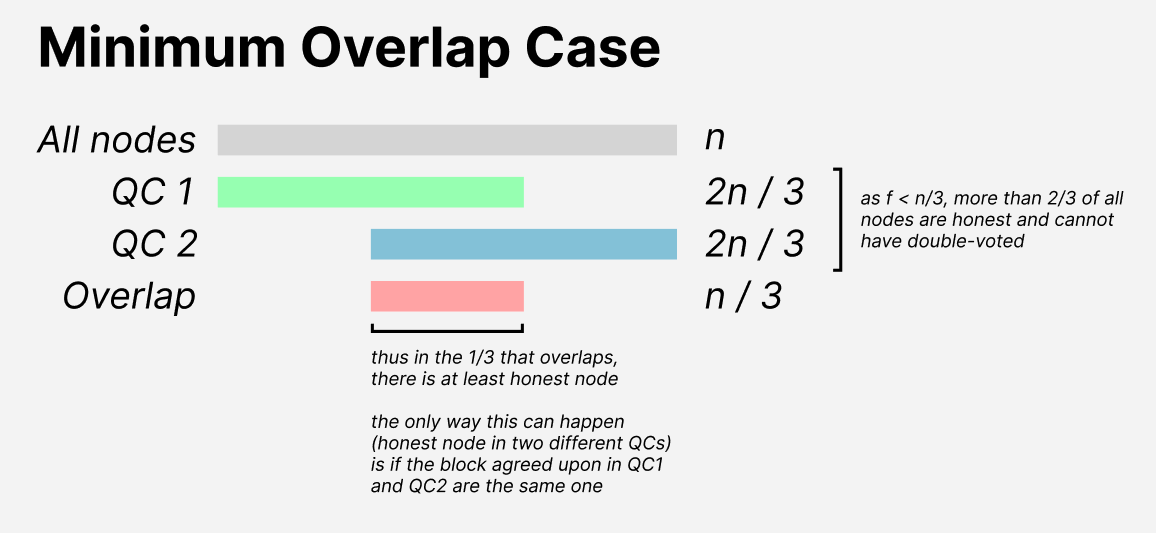Tendermint is most useful as an analog of Paxos/Raft but in a multi-stakeholder, or otherwise more adversarial, setting. However, the performance may not be as high due to the overhead of cryptographic operations
Source Paper, authored by Buchman, Kwon, Milosevic in 2018, stabilized in 2019.
A state machine replication protocol with a partially synchronous system model that, when , satisfies always consistency and eventually satisfies liveness (under the presence of an attack). However, the time to obtain a supermajority increases linearly with the number of nodes in the network.1
High-level ideas:
- Iterated single-shot consensus (something that looks like Byzantine Agreement) where the output of each single-shot consensus instance outputs a block (ordered list of transactions)
- For a fixed height, keep proposing + voting until agreement is reached
- Two stages of voting as different nodes may see different voting schemes
We assume PKI and a shared global clock. A round is timesteps, leaders are rotated once per round.
Properties
Quorum Certificate (QC) Lemma
A collection of a supermajority () of votes for a block in a particular round at some height and some stage . Any two QCs overlap in at least one honest node as and thus any two QCs must support the same block .

State
- Each node maintains a (, ) and periodically updates these variables block-QC pair it’s heard about
- Each node also keeps a local append-only data structure for blocks considered ‘delivered’
- Each node maintains it’s own height (which block it is currently working on) and ignores all messages about other heights
Pseudocode
Assume a specific height and round with leader . We split each round into 4 phases ().
- :
- updates to most recent QC known
- broadcast signed by to all other nodes
- :
- honest node will ignore the proposal if it seems out of date ( seems behind )
- if node receives from and it is up to date
- broadcast first-stage vote for
- update
- broadcast signed by
- else, do nothing
- :
- if node receives round- stage-1 votes (supermajority) for block ,
- if this occurs, all possible QCs must all support the same block (by QC overlap property)
- assemble QC from supermajority of votes
- set ,
- after witnessing a conclusive winner to the first stage, we broadcast second stage vote for
- broadcast signed by
- else, do nothing
- if node receives round- stage-1 votes (supermajority) for block ,
- :
- if node receives round- stage-2 votes for block ,
- set ,
- commit to local history
- broadcast signed by
- increment , re-initialize and to null
- else, do nothing
- if node receives round- stage-2 votes for block ,
- (just before round ):
- If we have heard of a stage-2 QC for block supporting block B
- commit to local history
- else, do nothing
- If we have heard of a stage-2 QC for block supporting block B
In the background,
- All honest nodes store all QCs received for future blocks
Proof of consistency
Definition of consistency: For a given block number, all honest nodes commit the same block .
This seems pretty obvious from the QC lemma but we can formalize this through proof by induction:
Assumptions
- Fix a height .
- Let be the first round in which honest nodes (set ) cast stage-2 votes for some block . is the first round in which a stage-2 QC could have been created.
Induction: at the end of round
- we know ,
- current is from round- stage-1 or later
- all QCs for other blocks are from round or earlier
These properties remain to be held in round given they hold in round as no nodes of change their mind.
Proof of liveness
Definition of liveness: if a transaction is known by all honest nodes, then it will get added to all of their local histories.
Note: this is a weaker definition of liveness than usual for SMR which states that if a single honest node knows about a transaction, then all honest nodes will eventually add that transaction to their local histories.
We define a clean round when
- we are post-GST
- there is an honest leader
- all honest nodes are working on the same block number
Proofs:
- Fast forward to pair of , consecutive rounds after with honest leaders , (this must be true for )
- Lemma: at the start of round , every honest node is working on either block or
- True because of the broadcast of a stage-2 QC at the end of , and all nodes should pick this up by and be working on at least
- Nodes could possibly be split between working on and if a Byzantine node keeps secret a stage-2 QC for and selectively forward it to honest nodes.
- Lemma: if there is a clean round, all honest nodes commit the block proposed by the leader
- By part 2 in assumption of clean round, after the update in the first phase, the leader’s QC is at least as recent as any other honest nodes.
- As we are post-GST, vote request will arrive at each node for where they all broadcast stage-1 votes for and have their local variable updated.
- Nodes assemble super majority for and can create a QC… same argument for stage-2 votes
- All nodes then commit to their local history
Footnotes
-
“There is a practical limit to how decentralized a blockchain with PBFT-based consensus can be. For instance, most Tendermint based blockchains only have 100-150 validators; this is done to strike a balance between time to finality and decentralization” (from Scott’s Guide to Finality) ↩